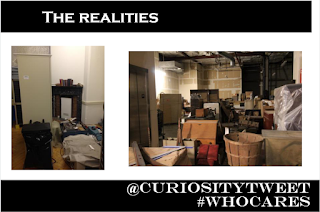On Friday 6th November we were fortunate to join academics, heritage professionals and researchers to discuss interventions in unloved museum collections for Who Cares? A conference hosted by a collaboration of PhD researchers from the Science Museum, Museum of English Rural Life, University of Birmingham and University of Reading and supported by AHRC the day looked into the emotional responses or lack of love in stored museum collections.
Its that there @curiositytweet presenting at #whocares on the enchantment of collections stores. pic.twitter.com/YGdSPRverO
— Alice Kershaw (@AliceKershaw) November 6, 2015
As you'll be aware by now both Kristin and I have spent our
careers working in museum stores and we even met in the deep dark basement of
Blythe house working with unloved collections, forming the Ministry out of our passion to make them accessible. So, we
decided to share our experiences by presenting
a paper on 'Becoming a Stores Explorer: Sharing Enchantment of Collections
through Social Media' aiming to weprovide an insight into the life as a stores
explorer (more about that later) and how we can communicate
the enchantment of the stores using social media.
We know only too well that if even if you work in a museum our role demands means that taknig an afternoon in the stores isn't possible without an object list or aim and for researchers and visitors their experience of
the stores is rightly so monitored by the watchful eye of a custodian. However, this
restriction is a necessary contribution to the enchantment of the stores. Some efforts have been made to make this experience accessible to the
public through open storage, but while highlighting to an extend the vast array
of objects in a store access is still restricted, prestigious and cleaner
objects are pushed to the front and visitors are invited to view behind glass but not to touch. The
unloved, dirty and broken are still hidden.
Here we call for our beloved social media to step in, by using digital
technologies can the stores explorer maintain or recreate the enchantment of
the stores?
But what is a stores explorer? If you’ve
worked in the stores you’ll probably have spent some time looking like this:
It's not pretty,
it͛'s not clean and it most certainly
isn'͛t always safe, or at least, it involves some
calculated and well-assessed risks. As a stores explorer you get to see the collection
in a varied and vast way as a researcher, a conservator, a registrar, you get to pick out those
that interest you and those objects that might kill you. The weight of the objects can
be your friend or your foe and you need a good head on your shoulders to try
and identify an object with just a brief description and a number. As a pioneer of the
unloved collections you get to roam freely put your object handling
Skills to good
use by touching the objects.
You may be a stores explorer yourself or feel a huge urge to be one. Can we not apply technologies and social media platforms to this approach whilst maintaining the protection of the stored objects?
Many institutions are already utilising the knowledge of their
staff through realistic solutions using collections staff on twitter and Tumblr
Time-lapse is a great tool and often used to show the time and work
that it takes to install an exhibition
But what about when Camberwell College have used it to show their
collections audit?
Periscope tours have also been used to explore exhibitions, but
what about a stores explorer wearing a go pro to explore the stores?
Then how about utilising more recent technological advancements?
Last week saw the launch of the British Museum on Cultural Institute,
exploring the whole of the museum in this way and highlighting key objects,
could a version of this be made for the stores?
What about 3D renders of objects, it’s
becoming more common on the closure of galleries or for objects that are
already on display but what about icing this for collections that haven’t
been shown for years and years?
There’s also oculist rift, exploring the
stores in this three sixty experiences allows incredible access without the
fear of damage or theft from the stores.
Then perhaps as a combination there’s haptic technology, soon coming to
your mobile haptic technology provides pressurised feedback and vibrations to
mimic touch.
Now mimicking the decaying smell of the stores may be a bit more
difficult, perhaps we can advise you on the smell for a collections based
perfume or scratch and sniff?!
Much of this technology is used for exhibitions; can we not use
it for their stores too?
We're available for further discussion and consultation on this topic
@curiositytweet or on email curiositycollect@gmail.com








No comments:
Post a Comment